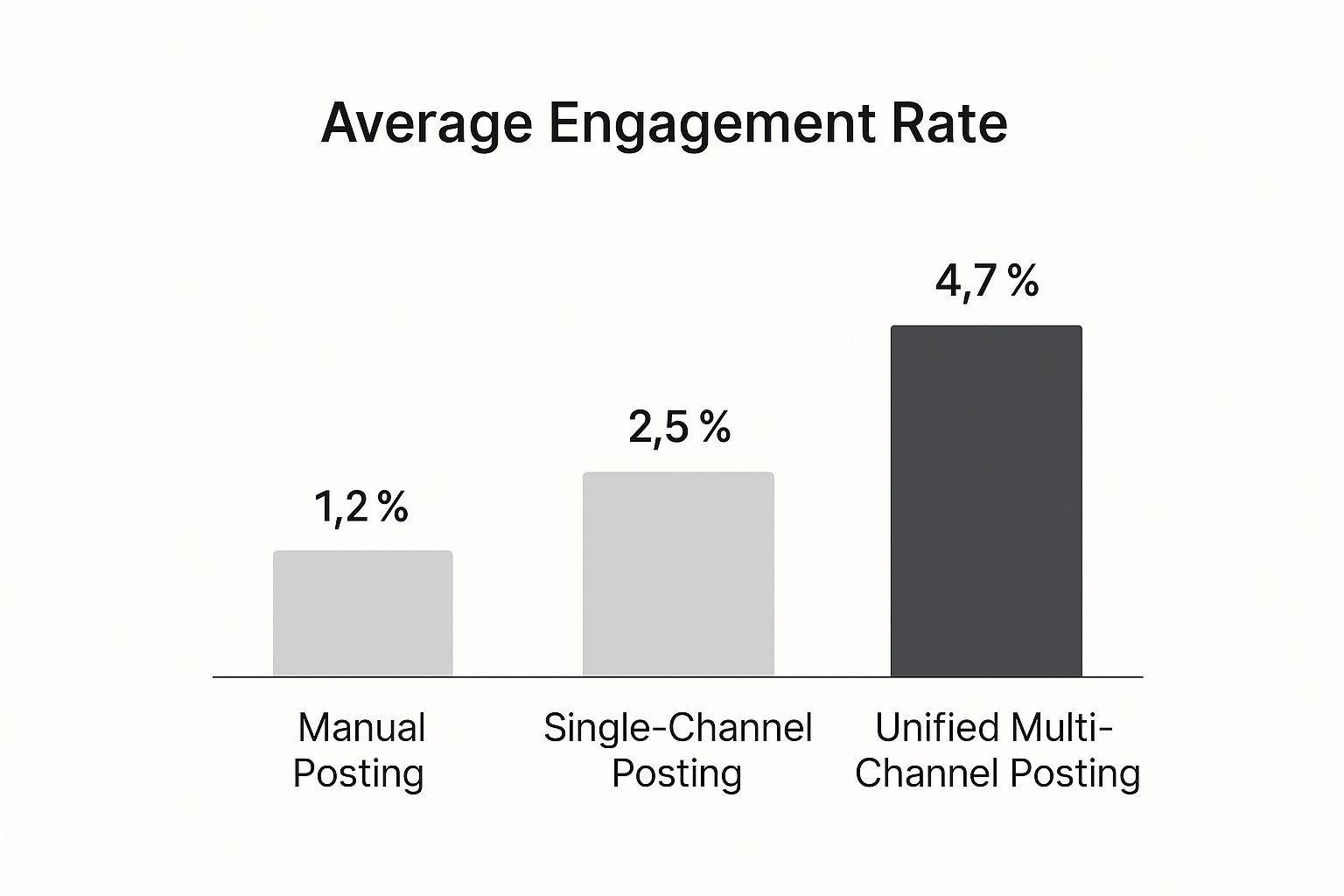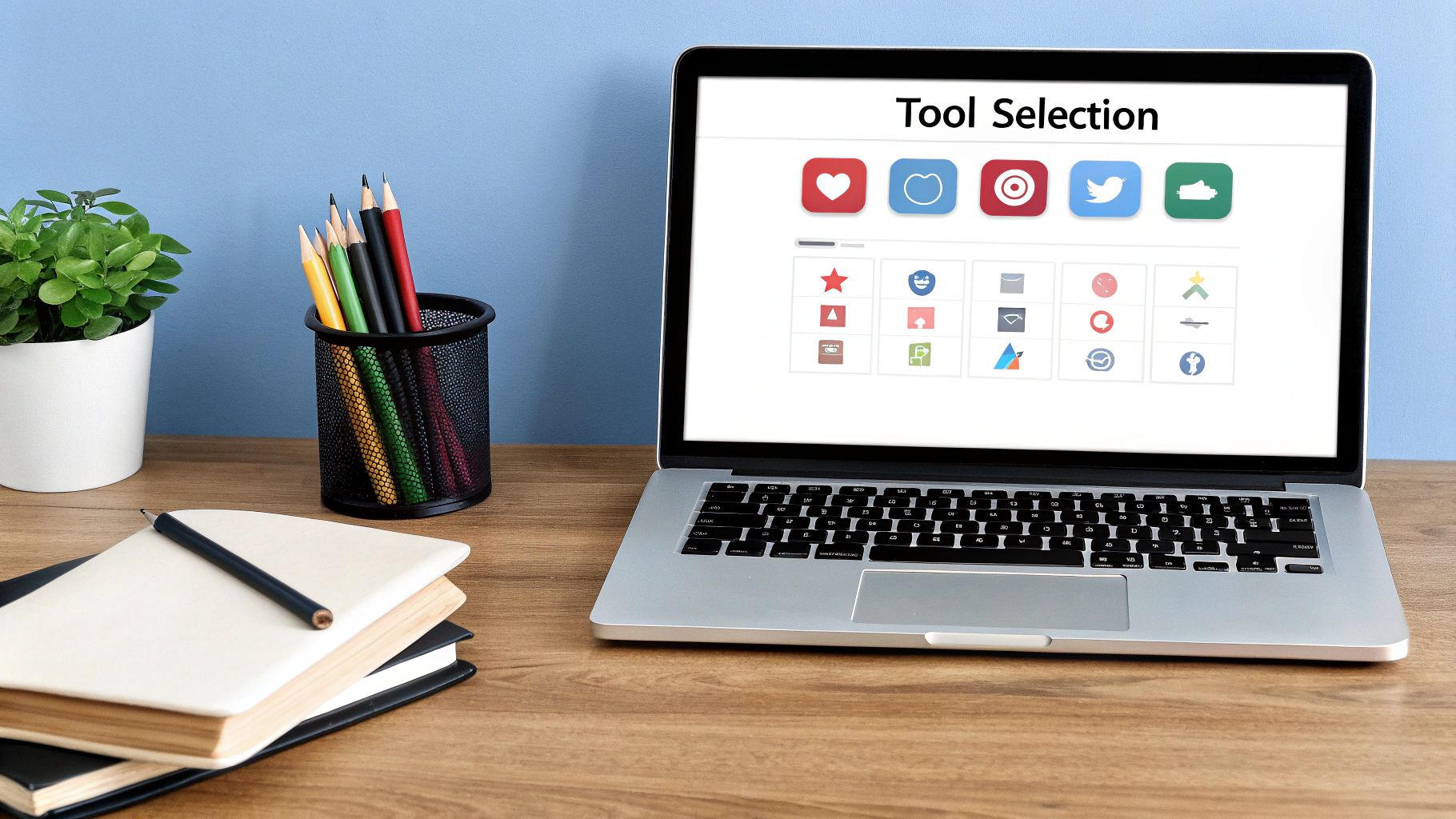Figuring out how to post to all social media at once isn't just a neat trick to save time—it's a critical strategy for dodging the very real, often unseen, costs of doing everything by hand. The old-school copy-paste routine feels productive, but it's quietly draining your creative resources, blurring your brand's voice, and opening the door to a ton of embarrassing mistakes.
The Hidden Costs of Manual Social Media Posting

Before we jump into building an automated workflow, we need to talk about why the manual approach is so damaging. Juggling multiple platforms by hand might make you feel busy, but it’s an inefficient system that’s actively working against you. The constant context-switching—flipping between different apps, interfaces, and audience expectations—creates a ton of mental friction.
That friction leads to predictable (and totally preventable) problems. You're always under pressure to just get something published, which leads to rushed work, cringe-worthy typos, or broken links that instantly tank your credibility.
Inconsistency and Brand Dilution
Every time you manually craft a post for a different platform, you're rolling the dice on consistency. The tone might be slightly different. The core message might get tweaked. The branding might be just a little off. On their own, these are small slips, but over time, they create a fractured brand identity.
Soon, your audience on LinkedIn is getting a different vibe from your followers on Instagram, and your brand becomes diluted and confusing. A strong brand story is built on consistency, and manual posting makes that incredibly hard to pull off.
The real cost of manual posting isn't just the hours you lose; it's the brand coherence you sacrifice. Every inconsistent post chips away at the trust and recognition you've worked hard to build.
The Creative Drain of Repetitive Tasks
Let's be honest, real social media success comes from great ideas and engaging content, not from mind-numbing admin work. Spending your best hours copying text, uploading the same image five times, and triple-checking character counts is a massive waste of creative energy.
This repetitive loop is a fast track to burnout. It eats up the mental bandwidth you should be using for the stuff that actually matters:
- Strategic Planning: Digging into what's actually working and resonating with your audience.
- Creative Ideation: Coming up with new campaigns and genuinely interesting content.
- Community Engagement: Actually talking to people, responding to comments, and building relationships.
Automating the grunt work frees you up to focus on the high-impact activities that truly grow your brand.
Why a Unified Social Strategy Is Non-Negotiable
Let's get one thing straight: simply blasting the exact same generic message across all your social profiles is a fast track to low engagement. It's the social media equivalent of shouting into the void.
A truly unified strategy, on the other hand, is about building a cohesive brand story that connects with your audience, no matter where they find you. Think of it as creating a compounding effect, where your presence on Instagram, X, and LinkedIn all work together to reinforce your core message and build real authority.
This coordinated approach is what turns a bunch of disconnected updates into a powerful engine for brand building. When followers see a consistent, high-quality presence everywhere, it builds trust. It makes your brand feel reliable and professional. The goal isn't just to post to all social media at once; it's to do it in a way that feels intentional, not just automated.
The Compounding Effect of a Multi-Channel Presence
Being on multiple platforms isn’t just about reaching more eyeballs. It’s about reaching your existing audience in different contexts, which deepens their connection to your brand. Each channel is a unique touchpoint to tell a different part of your story.
For example, a casual behind-the-scenes look on Instagram Stories can perfectly complement a more buttoned-up, professional case study you share on LinkedIn. They're two different pieces of the same puzzle.
This multi-channel reinforcement is incredibly powerful for growth. The numbers don't lie. Brands that deploy cross-platform strategies see far better results than those siloed on a single channel.
We've seen it time and time again:
- Campaigns using three or more channels see a 14.6% higher sales lift.
- Customers who engage with a brand across multiple touchpoints spend about 30% more.
- And the most compelling stat? Cross-channel brands enjoy an 89% average customer retention rate.
If you want to dig deeper, you can find a lot more data on the impact of integrated marketing to back this up.
A unified strategy means every post, on every platform, supports the others. It creates a seamless brand experience that turns casual followers into loyal advocates who see you as a consistent and authoritative voice in your space.
To really nail down the difference, let's look at how campaign metrics stack up when you go from a single channel to a multi-channel approach.
Single-Channel vs Multi-Channel Campaign Impact
| Metric | Single-Channel Performance | Multi-Channel Performance |
|---|---|---|
| Reach & Awareness | Limited to one platform's audience | Broader reach, multiple touchpoints |
| Engagement Rate | Typically lower, audience fatigue | Higher due to diverse content formats |
| Lead Generation | Dependent on a single funnel | Multiple funnels, higher conversion |
| Customer LTV | Lower, fewer interaction points | ~30% higher due to deeper relationships |
| Customer Retention | Moderate, relies on one platform | Up to 89% through consistent presence |
As you can see, the data consistently shows that a multi-channel strategy doesn't just add a little boost—it creates a significant lift across all the metrics that actually matter for business growth.
Visualizing the Impact on Engagement
The difference between scattered, single-platform posting and a truly unified strategy becomes crystal clear when you look at the engagement data. The infographic below compares the average engagement rates across different posting methods, and the results speak for themselves.

As the data shows, a unified multi-channel strategy significantly outperforms other approaches, nearly doubling the engagement rate of single-channel efforts. This proves that a cohesive, cross-platform plan doesn’t just save you time—it actively boosts the metrics that move the needle.
When you thoughtfully post to all social media at once, you’re not just broadcasting. You’re building a conversation that grows stronger and more valuable with every platform you use.
Choosing the Right Social Media Automation Tools

The secret to being able to post to all social media at once isn't just about grabbing any tool; it’s about finding the right one. The market is flooded with platforms that all promise to cure your scheduling headaches, but they're definitely not all built the same. Your mission is to find a solution that centralizes your workflow while respecting the unique vibe of each social network.
A truly great tool goes way beyond basic cross-posting. Sure, a unified content calendar is a must-have for seeing your strategy at a glance, but the real magic is in the customization. It should let you write a core message once, then quickly tweak the caption, hashtags, and visuals for Facebook, X, Instagram, and LinkedIn without ever leaving the dashboard.
These management tools have completely changed the game. Today, 90% of businesses lean on AI-driven platforms to manage their cross-posting, and 73% report a real jump in engagement from content that's had a little AI help. They’re invaluable for adapting visuals and timing to fit what each platform's audience expects.
Core Features to Look For
When you're shopping around, try to look past the flashy landing pages and focus on the features that will genuinely impact your day-to-day. The real non-negotiables are all about efficiency, smarts, and adaptability.
Here are the key things I always tell people to prioritize:
- Platform-Specific Customization: You absolutely need the ability to tweak text, image dimensions, and calls-to-action for each network. A copy-pasted post sticks out like a sore thumb and just doesn't perform.
- Predictive Scheduling Analytics: Look for a tool that crunches the data on your audience's activity and suggests the best times to post for each platform individually.
- Unified Inbox: Juggling comments and DMs across five different apps is a recipe for disaster. A central inbox pulls all those conversations into one place so you can actually respond on time.
- Robust API Access: If you're a developer or part of an agency, a powerful API like Late's is a game-changer. It’s what lets you build custom workflows or bake scheduling right into your own products.
The best automation tool doesn't just broadcast your message; it helps you tailor it. It should feel less like a megaphone and more like a translator, ensuring your content speaks the native language of every platform it touches.
Finding the Right Fit for Your Scale
The perfect tool for a solo creator looks nothing like what a big marketing agency needs. A solopreneur probably cares most about a clean interface and a friendly price tag. An agency, on the other hand, will need multi-client dashboards, team collaboration features, and detailed approval workflows.
For a deeper look at how this plays out, check out our guide on https://getlate.dev/blog/automating-social-media, where we break it down for different use cases.
And it doesn't stop there. Beyond the all-in-one platforms, you can find specialized AI tools specifically for content creation that help fine-tune your messaging for maximum impact. In the end, your choice has to line up perfectly with your budget, your team's size, and where you're trying to go long-term.
Setting Up Your Automated Posting Workflow
Alright, let's get our hands dirty. Moving from just talking about automation to actually building it is where the magic happens. Setting up a workflow to post to all social media at once isn't rocket science, but it does need a smart, deliberate approach. This is about more than just plugging in your accounts; it's about building a system that works for you, respecting what makes each platform unique.
The first move is always consolidation. You have to get all your profiles—Facebook, Instagram, X, LinkedIn, you name it—into one central spot. This is the bedrock of your whole strategy. It gives you a single command center to see and manage everything without bouncing between a dozen different apps. Trust me, that unified view is the key to keeping your brand message straight.
Connecting Your Social Accounts
The first real step is to authenticate your social media accounts with whatever tool you're using. This is just a secure login that gives the platform permission to post for you. It's a simple but absolutely critical part of the process.
For instance, connecting an Instagram Business account is what lets you post Reels and Stories directly. Linking LinkedIn unlocks scheduling for your professional network. A rookie mistake I see all the time is people forgetting to connect one or two accounts at the start, which leaves glaring holes in their content calendar down the road.
A good dashboard will lay out all your connected profiles so you can see everything at a glance, usually with their own posting queues.
The screenshot above is a perfect example. It shows how a management tool centralizes everything, giving you a bird's-eye view of your scheduled content. This is exactly what you need to spot gaps and make sure you have a balanced, consistent presence everywhere.
Crafting and Customizing Your Core Content
Once you're all linked up, it's time to create. The most efficient way I've found to do this is to start with one high-quality "master" post. This is your core message, your main visual (an image or video), and your primary call-to-action, all rolled into one.
Now, here’s where you get clever: you adapt, don't just duplicate.
- For LinkedIn: Tweak the caption to sound more professional. Maybe add a question to get a business-focused conversation started or tag a few relevant companies.
- For Instagram: It’s all about the visual. Make sure that image is cropped perfectly. Write a caption that feels more personal and engaging, then throw in a solid set of relevant, trending hashtags to get more eyes on it.
- For X (formerly Twitter): Your message needs to be short and punchy. Cut it down to the essentials to fit the character limit. Adding a poll or a GIF can seriously boost engagement here.
This approach ensures your core message stays consistent, but the delivery is perfectly tuned for each audience. If you're looking for a good starting framework, our guide on building a social media workflow template is packed with actionable steps.
Mastering Advanced Scheduling
With your content tailored for each platform, the last piece of the puzzle is scheduling. This isn't about just throwing your posts on the calendar at random times. It's about being strategic. You want to hit your audience when they're most active. Most modern tools even give you data-backed suggestions for the best times to post, which takes out all the guesswork.
The real goal of an automated workflow is to plan weeks, or even months, in advance. This is what shifts your social media from a reactive, daily grind to a proactive, strategic operation.
When you batch your content creation and schedule it way ahead of time, you free up so much mental space. You can then focus on what really moves the needle: engaging with your community and digging into your performance data. This structured system is what separates a chaotic, messy social presence from a well-oiled marketing machine.
How to Post Everywhere Without Sounding Robotic

Automation gives you speed, but authenticity is what actually builds a community. While the ability to post to all social media at once is a massive time-saver, it comes with a big risk: sounding like a copy-paste robot.
The secret to avoiding this trap is embracing the "Adapt, Don't Duplicate" mindset.
It means you never, ever broadcast the exact same message across all your channels. Every platform has its own vibe, its own unwritten rules, and its own audience expectations. A data-heavy, professional post that gets amazing engagement on LinkedIn will almost certainly bomb on TikTok, where people expect short, punchy, and entertaining videos.
The Adapt, Don't Duplicate Principle
Real efficiency isn't just about doing things faster; it's about getting better results. The goal is to reshape your core message to fit the native language of each platform. And no, this isn't just about tweaking a few words.
Think about adjusting these key elements for every single post:
- Tone of Voice: Your LinkedIn posts should sound professional. Your Instagram or X posts? Far more casual and conversational.
- Visuals: Make sure your images and videos are formatted correctly. That means vertical for Reels and TikTok, but landscape for a platform like Facebook or YouTube.
- Calls-to-Action (CTAs): A "Learn More" link is perfect for Facebook, but you need to use a "Link in Bio" prompt on Instagram.
- Hashtags and Mentions: Broad, trending hashtags can work wonders on Instagram, while you'll want to use more niche, community-focused ones on LinkedIn.
The point of automation isn’t just to blast your message out there. It’s to buy back your time so you can focus on building real communities where your brand lives. Genuine engagement is the only currency that matters on social media.
This level of customization is absolutely critical. With over 5.4 billion people scrolling social media every day, audiences are sharper than ever. They can spot lazy, duplicated content from a mile away, and it instantly kills trust.
Monitoring and Engaging From One Place
Authenticity isn't just about what you post—it's about how you listen. Firing off content without ever checking the replies is like giving a speech and then immediately walking out of the room. It makes your audience feel completely ignored.
This is where a unified dashboard becomes your best friend. It lets you track all your comments, mentions, and DMs in one clean feed, which is a total game-changer for community management.
- Respond Quickly: You can jump on questions and feedback almost instantly, showing your followers that you're actually there and paying attention.
- Spot Trends: When you see all the conversations in one place, you can easily pick up on recurring questions or hot topics your audience is buzzing about.
- Maintain Brand Voice: A single person or team can manage all engagement, which keeps your tone consistent and helpful across every platform.
If you need some inspiration to get your cross-platform content flowing, check out these 10 creative social media post ideas. When you combine smart customization with active listening, you can scale your presence without losing that all-important human touch. For a deeper dive, read our guide on essential social media posting best practices.
Common Questions About Cross-Platform Posting
Even with a solid workflow, a few questions always pop up once you start to post to all social media at once. Let's clear the air on these common concerns—getting them right is key to building a strategy that works instead of one that backfires.
Will Posting the Same Thing Everywhere Hurt My Engagement?
Honestly? Yes, it absolutely will—if you're just copying and pasting without a second thought. Both your audience and the platform algorithms are smart enough to spot generic, low-effort content from a mile away. A post that feels out of place or ignores native features is a fast track to tanking your engagement.
The right way to do it is to use a central tool to manage your core message, but always customize it for each network. This means tweaking the caption's tone, using platform-specific features like polls on X or stickers on Instagram, and resizing your visuals so they look great everywhere. The goal is message consistency, not lazy content duplication.
It's a fundamental misunderstanding to think that cross-platform posting means identical posting. The real value comes from maintaining a cohesive brand voice while speaking the unique language of each platform.
What Is the Best Time to Post to All Platforms at Once?
This is a trick question. There’s no single "best time" that works everywhere. That idea is one of the biggest myths in social media management. The professionals on your LinkedIn feed are most active during the 9-to-5 grind, while your TikTok audience is probably scrolling late into the evening.
Any decent social media tool will give you scheduling recommendations based on your specific audience's activity on each platform. So, the best practice isn't to blast everything out at once. Instead, schedule each post for its own optimal time on its own platform. This staggered approach respects how people actually use these apps and gives your content a much better shot at getting seen.
How Many Social Media Platforms Should I Actually Use?
The classic mistake is spreading yourself too thin. It's so much more effective to build a strong, engaged community on two or three platforms where your audience actually lives than it is to maintain a weak, inconsistent presence across seven different apps.
Quality will always, always beat quantity. Start with the channels that matter most to your brand. Nail your automated workflow there. Only then should you even consider expanding, and only if you have a sustainable process that won't make your content quality suffer. Let your data and your team’s bandwidth guide this decision, not the pressure to be everywhere at once. The goal is to make a real impact where it counts.
Ready to streamline your cross-platform strategy with a powerful, developer-first API? Late lets you connect to ten major social platforms through a single, reliable integration.